Windhoek Travel Guide
Windhoek is the small, attractive capital of Namibia and is situated in the Central Highlands. Surrounded by hills and mountains, it is the country's largest city and occupies the country's geographic and economic heart.
The city centre is characterised by historic German colonial architecture and imposing modern structures. Dominating the skyline is the striking German Lutheran church, Christuskirche, a mixture of Art Nouveau and neo-Gothic design, and the Titenpalast, or 'Ink Palace', the parliament building from where the sparsely populated country is governed.
The railway station is a Cape Dutch edifice dating back to 1912, and the tree-lined Independence Avenue contains pleasant fountains and walkways. It provides a relaxing ambience among the modern buildings of the central business district.
The women of the Herero tribe are very distinctive with their voluminous Victorian-style dresses and colourful headgear, and are the cattle herders of the region; the German influence extends beyond architecture to include the food and locally brewed beer. Polony and sauerkraut are available on the menu among local dishes, and visitors can also dine seafood from the west coast and venison or game steaks from the hinterland. Eating out in Windhoek is a fun and unique experience.
Things to do in Windhoek
A holiday in Windhoek is flavoured with traditional brews, as well as sausage and sauerkraut. Visitors will also find a great mix of colourful African culture and colonial architecture that will leave them in no doubt they are in the commercial heart of a vast southern African country.
Namibia's main point of entry is by air. Most of those who travel to Windhoek come to use it as a jumping off point for a safari trip or desert expedition, spending a few days getting to know the city at the beginning or end of their journey.
Tourist attractions in Windhoek include the imposing Lutheran Christuskirche, an interesting architectural hybrid, while the Alte Feste, translated to 'Old Fortress', was once the German military headquarters that now operates as a state museum.
There's also the Owela Museum, which showcases the country's diverse ethnography, and the National Botanic Gardens, which are great for a stroll and a picnic. The city is well-situated to act as a springboard to many desert attractions nearby.
The sun shines nearly every day of the year, and the weather is always warm to mild, even in midwinter, so there is no best time weather-wise to travel to Windhoek. However, summers may be too hot for some, so a preferable period to holiday in Windhoek is either side of the hottest months, between April and June or March and October.
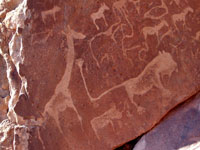
Twyfelfontein
Twyfelfontein boasts the largest concentration of ancient rock art in the country, and is a UNESCO World Heritage Site. The petroglyphs primarily depict game animals such as giraffe, antelope, elephant, and lion, and the oldest carvings may date back 10,000 years. Most are believed to be around 3,000 years old. Translated as 'uncertain fountain', Twylfontein got its name from a farmer who doubted the spring's ability to sustain their cattle for a long period. Visitors can't enter the site without a guide due to previous vandalism. The uniquely designed visitor information centre features an exhibition, kiosk, and souvenir shop. Other stunning sights in the area around Twyfelfontein include the Organ Pipes, the Doros Crater, and the Petrified Forest.
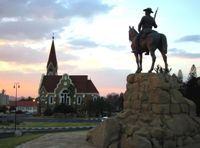
Christuskirche
Christuskirche is a prominent landmark in the historic centre of Windhoek. A 79-foot (24m) spire tops the sandstone church, and is a national monument. Its portal and altar are Italian marble, and its gothic revival face is unique by virtue of its Art Nouveau elements, which are made from quartz sandstone. Interestingly, the stained-glass windows, a gift from Emperor Wilhelm II, were installed backwards until the late 1990s, when a tourist noticed the error. The church is a delight to explore, especially for those interested in architecture. The Parliamentary Gardens are wonderful for a stroll and a picnic, and are just around the corner from the church. There is also a small craft market nearby.
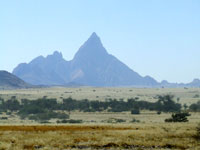
The Spitzkoppe
The natural beauty of the Spitzkoppe is spectacular: an island of bald granite peaks situated in an endless grassy plain that is visible for miles around. Groot Spitzkop is often referred to as the 'Matterhorn of Africa' because of its similarity in shape, and it is one of Namibia's most famous mountains. Nearby are the Little Spitzkoppe and the Pontok Mountains. Many San rock paintings exist in the Spitzkoppe area, and these ancient artworks are thrilling to seek out. At the foot of Groot Spitzkop, Rhino Rock boasts some of the best surviving examples of prehistoric rock paintings. Sadly, many have been destroyed. The area is also renowned for its breath-taking sunrises, which turn the rocks from pale orange to flaming gold.

Brandberg
The Brandberg Massif is famous for its thousands of rock paintings and engravings. Its most celebrated piece is the 'White Lady', estimated to be around 2,000 years old. The painting shows a male with the white colour representing body paint which suggests it is a medicine man. Discovered in 1955, there has been a great deal of controversy over the meaning and origin of the painting. The mountain is a sacred place for the San tribes in the region. Brandberg's highest peak is Konigstein, and at 8,550 feet (2,606m), it is the highest mountain in Namibia.
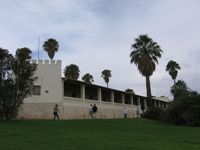
Alte Feste (Old Fortress)
The Alte Fest, also known as the Schutztruppe Fort, served as the German colonial power's military headquarters until after World War One and today houses the state historical museum. German commander Curt von Francois laid the foundation stones in 1890, making it one of the oldest buildings in Windhoek and a significant national monument. In fact, the modern city more or less grew around the fort. Today, the museum's exhibition informs visitors of Namibia's history from its San origins to German occupation in 1884 and the resulting struggle for independence. The museum is a bit old-fashioned and rundown but still interesting. Emphasis is on the revolutionary struggle, with fascinating old photographs.
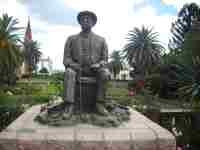
National Botanic Garden
The National Botanic Garden of Namibia is a 12 hectare (30 acre) nature reserve in the heart of Windhoek, where tourists can hike, picnic, and learn about the country's fascinating plant life. The small nature reserve only opened to the public in the 1990s. The gardens are great for birdwatching, with lists of plants and birds found in the reserve available at reception. Guided tours are also in operation but should be booked in advance. The gardens can get very dry in winter, between June and September, and are at their most splendid when the plants are lush and in bloom during the rainy season, which is the best time to visit.
Windhoek Climate and Weather
Windhoek has a semi-desert, arid climate, with very hot summers and mild winters. Temperatures tend to drop dramatically at night. Windhoek is blessed with sun almost every day of the year (on average 300 days a year are sunny), and every season has its advantages for travel.
Average temperatures in winter (between June and August) range from 43F (6C) to 70F (21C). Nights are cold and warm clothes are necessary, but temperatures seldom dip below 32F (0C) and it almost never snows.
Winters are usually very dry and little or no rain falls between May and September. December is the wettest month of the year. The region is susceptible to drought, and a serious drought hits every decade or so. Temperatures in summer (between November and February) range from the pleasantly warm to the swelteringly hot, with daytime temperatures frequently hitting 30C (86F).
The most popular time to travel to Windhoek is between March and October, in particular between April and June, when rainfall is lowest and temperatures are mild. Winter is also best for game viewing, as animals tend to congregate around water and are easier to spot.
Namibia travel info
Electricity
Electrical current is 220 volts, 50Hz. Round three-pin plugs are standard.
Language
English is the official language, but many people also speak Afrikaans and German. There are also several indigenous languages spoken, mainly in the rural areas.
Money
The official currency is the Namibian Dollar (NAD), which is divided into 100 cents. Its value is equal to the South African Rand, which is accepted as legal currency in Namibia. Major credit cards are accepted, while foreign currency can be exchanged at any bank or bureau de change. ATMs may not be available in remote areas.
Tipping
Tips of 10 percent are expected where a service charge has not been included in the bill. Tour guides, game rangers, and trackers rely on tips for their income and should be tipped accordingly.
Health
Typhoid, hepatitis A, and hepatitis B vaccinations are recommended for travel to Namibia. Safety regulations in Namibia require all visitors who are over the age of nine months to have a yellow fever certificate if they're arriving from a country with a risk of transmission. There is a malaria risk in the northern region of Namibia during the rainy season (January to April).
There has been an increase in the cases of rabies among dogs in Windhoek, so travellers at risk of animal bites should consider a rabies vaccination; everyone five years of age and older should get fully vaccinated for COVID-19 before visiitng. HIV/AIDS is prevalent and precautions are essential, although travellers are seldom at risk unless engaging in unprotected sex. Cholera outbreaks do occur, so visitors should drink only boiled or bottled water, avoiding ice in drinks.
There are good medical facilities in Windhoek, but medical insurance is essential as treatment is expensive. Outside of the main cities, medical treatment may be hard to come by. Travellers to Namibia should seek medical advice at least four weeks prior to departure. For peace of mind, it is best to take prescription medications along when travelling. Medicines should be kept in their original packaging and accompanied by a signed and dated letter from a doctor, detailing why the medication is needed.
Safety
The majority of visits to Namibia are safe and trouble free, but muggers in Windhoek sometimes target foreign tourists. Theft from vehicles does occur, especially at service stations, so valuables should be kept out of sight and cars should be locked. Travellers should avoid using taxis if possible and should never take one alone. It's best to be especially careful when travelling in the Caprivi Strip; drivers should use it during daylight hours only, both for general safety and to avoid livestock, which wander onto roads causing accidents. The terrorism threat in Namibia is very low, with no major incidents of violence against foreigners reported.
Local customs
It is best to check before taking pictures of State House or properties where the President is residing, as well as any buildings guarded by the army or police. Some sexual relations between men are criminalised in Namibia, although these laws may not always be enforced.
Doing business
Business in Namibia is somewhat formal, although drinking and socialising are an important part of building good working relationships. Standard business etiquette applies. Dress tends to be formal, though lightweight materials tend to be worn in the hotter seasons, and punctuality is important. People shake hands on greeting and leaving, and are generally polite and professional. English is the language of business, though German and Afrikaans are widely spoken. Business hours are usually 9am to 5pm, Monday to Friday.
Duty free
Travellers to Namibia over 16 years do not have to pay duty on 400 cigarettes, 50 cigars and 250g of tobacco; 2 litres wine and 1 litre spirits or liquor; 50ml perfume and 250ml of eau de toilette; and gifts to the value of NAD 1,250.
Communications
The international access code for Namibia is +264. The outgoing code is 00 followed by the relevant country code (e.g. 0027 for South Africa). Large parts of the country are not covered by the mobile network, so a satellite phone is a good backup option for those heading off the beaten track. WiFi is increasingly available in hostels, hotels, lodges and guesthouses; travellers can purchase local prepaid SIM cards for unlocked phones.
Passport & Visa
All foreign passengers to Namibia must have confirmed return or onward tickets, and the necessary travel documentation for their next destination. Additionally, visitors should ensure that they have at least two blank pages remaining in their passports for entry and departure endorsements from the Namibian Immigration Service. A yellow fever vaccination certificate is required to enter Namibia if visitors are arriving from or have transited through an infected area. All travellers must have a passport that is valid for at least six months beyond the period of intended stay in Namibia.
Entry requirements
US citizens must have a passport that is valid for at least six months beyond their planned date of departure, and at least three completely blank pages are required for entry. No visa is required for tourist or business-related stays of up to three months.
British passports should be valid for a minimum period of six months from the date of entry into Namibia and have at least one completely blank page for Namibian immigration to use. If British travellers are also visiting South Africa, they should be aware that although South African authorities state they require one blank passport page for entry, some officials insist on two blank pages. If travellers plan to take this route, they should make sure they have a total of three blank pages. No visa is required for tourist or business-related stays of up to three months.
Canadian passports must be valid for a minimum of six months after the date of entry to Namibia, but no visa is required for tourist or business-related stays of up to three months.
Australian passports must be valid for a minimum of six months after the date of entry to Namibia, but no visa is required for tourist or business-related stays of up to three months.
South African passports must be valid for a minimum of six months after the date of entry to Namibia, but no visa is required for tourist or business-related stays of up to three months.
Irish passports must be valid for a minimum of six months after the date of entry to Namibia, but no visa is required for tourist or business-related stays of up to three months.
New Zealand passports must be valid for a minimum of six months after the date of entry to Namibia, but no visa is required for tourist or business-related stays of up to three months.
Useful contacts
Namibian Tourist Office, Windhoek: +264 (0)61 290 6000 or info@namibiatourism.com.na or www.namibiatourism.com.na
112 (fire and rescue, police, medical emergencies)Embassies / consulates in other countries
Embassy of Namibia, Washington DC, United States (also responsible for Canada): +1 202 986 0540.
Namibia High Commission, London, United Kingdom (also responsible for Ireland): +44 (0)20 7636 6244.
Namibia High Commission, Pretoria, South Africa: +27 (0)12 481 9100.
Embassies / consulates in Namibia
United States Embassy, Windhoek: +264 (0)61 295 8500.
British High Commission, Windhoek: +264 (0)61 274 800.
Canadian Consulate, Windhoek: +264 (0)61 251 254.
Australian High Commission, Pretoria, South Africa (also responsible for Namibia): +27 (0)12 423 6000.
South African High Commission, Windhoek: +264 (0)61 205 7111.
Irish Embassy, Lusaka, Zambia (also responsible for Namibia): +260 211 291 298.
New Zealand High Commission, Pretoria, South Africa (also responsible for Namibia): +27 (0)12 435 9000.



